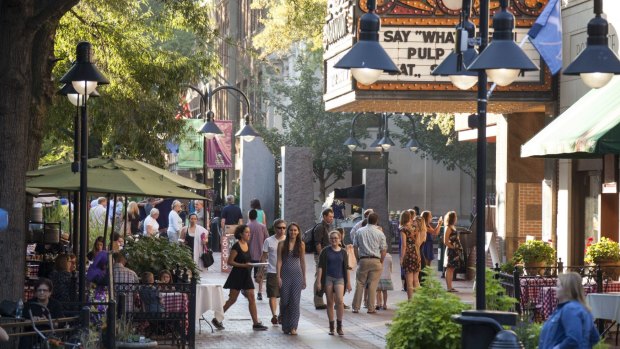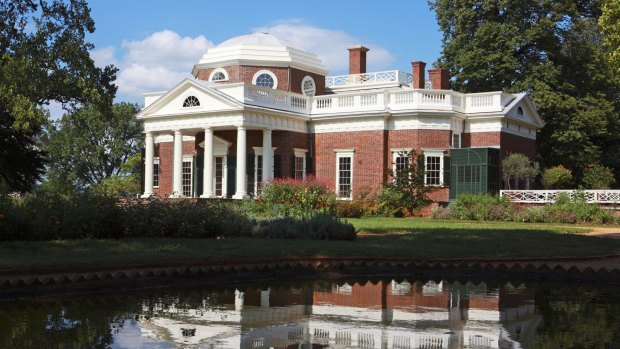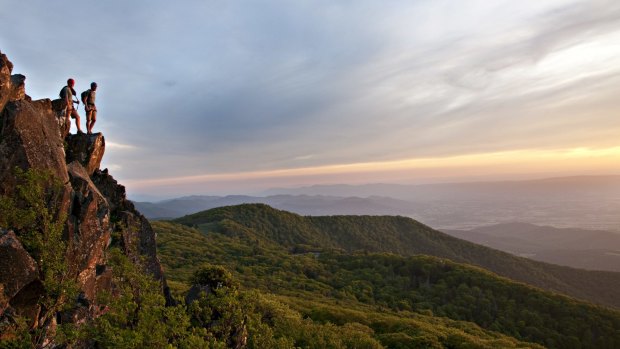This was published 4 years ago
Charlottesville travel guide: Reconciling beauty with the shadows of America's past
By Lance Richardson

Pretty as a picture: Charlottesville's Downtown Mall.Credit: Virginia Tourism Corporation
The main street of Charlottesville, Virginia, makes Disneyland look shabby. Tall oak trees shade alfresco diners on a red-brick mall, so perfect it seems manufactured by Hollywood. A neon sign flashes over the Paramount Theatre, and a busker tries his luck with an acoustic guitar. In every direction are shops, of course, but unusual, one-of-a-kind shops.
Timberlake Drugs was founded in 1890, and its window still advertises a soda fountain and "fine candy." Chaps is a milk bar so beloved that the threshold has been worn down by millions of footsteps. A restaurant called the Nook dates back to 1951; a bookshop named the New Dominion dates to 1924. The cumulative effect is a vision of small-town America that, everywhere else, seems a faded dream.
It is difficult to reconcile this quiet beauty with the knowledge of what happened here two years ago, in August 2017. White supremacists held a rally, proudly waving Confederate flags as they chanted neo-Nazi slogans. There was a series of tense stand-offs with counter-protesters, culminating in horrific violence: one of the white supremacists drove his car through a crowd of protesters on the Downtown Mall, killing a 32-year-old woman and injuring 19 others.

Monticello, the home of Thomas Jefferson, the third president of the United States.
I remember being baffled at the time by what I was watching on television. What was going on in Charlottesville, often described as the happiest place in America? The answer, it turns out, was perhaps best put by William Faulkner in his famous adage: "The past is never dead. It's not even past."
A visit to Charlottesville today offers many pleasures for a curious traveller. The city is stunning, and it offers hiking trails, kayaking, and hot-air ballooning. It is possible to find vintage bargains in places such as Blue Whale Books, which lists "books about books" and "Virginiana" among its voluminous stock. There are good wineries dotted around the landscape.
But a visit to Charlottesville is also a fascinating opportunity to watch a place grappling with the painful truths of its own history. This is what I find most compelling.

Shenandoah National Park is a great place to take advantage of Virginia's natural beauty.Credit: Virginia Tourism Corporation
For years, slavery has been politely avoided as a topic of discussion in Virginia. No longer. For example, strolling through the University of Virginia, which takes up a large slice of real estate near the mall, I am awed by the Rotunda, modelled after the Pantheon in Rome. Students lounge on the lawn in its imposing shadow, some singing a cappella as if they're trying out for Pitch Perfect 4. But then there are flyers pasted to walls around them, impossible to miss: "Remember the enslaved." And a large construction site in the middle of campus heralds an upcoming "Memorial to Enslaved Laborers" – a memorial to the people who actually built this institution. A mock-up drawing of the sculpture, which resembles a circular moat without water, shows these same students reclining inside the constant reminder.
The University of Virginia was designed by Thomas Jefferson, third president of the United States. One morning I drive to his house, Monticello, which sits to the south of town. A UN World Heritage Site, Monticello is a marvel for many reasons. Chief among them is its newfound willingness to tackle Jefferson's more difficult characteristics. "He was not the only president to own slaves," the guide announces on my tour, "but he did write the Declaration of Independence, which makes him a puzzle to a lot of us."
In 2018, six groundbreaking exhibits opened here that focus on the 607 enslaved people Jefferson owned in his lifetime. One of them, The Life of Sally Hemmings, is a multimedia display that tells the story of a woman who bore Jefferson five children, even as she was listed in his "farm book" alongside the livestock.
"I know it's a lot to take in, but it is what happened here," another guide tells the crowd on Monticello's Slave Tour. This guide goes so far as connect Hemmings and the "great imbalance of power" between her and Jefferson to the current Me Too movement. As a visitor, the effect of this is not depressing but inspiring, even uplifting. It is as though a heavy curtain has been pulled aside and light is streaming into a dark room for the first time in decades.
A little north of Charlottesville is Montpelier, the house of James Madison, who was another of the Founding Fathers. A great friend of Jefferson's and the man who wrote the Bill of Rights, Madison also owned numerous enslaved people. They ran his tobacco plantation while he mulled the principles of individual liberty in his upstairs library.
At Montpelier, an important readjustment in the narrative has taken place over the last year or two. While the house tour still seems to tread gingerly around the issue – my guide spends far more time extolling the lavishness of the Madison's dinner parties than he does on the people who made the food – the new exhibit in the cellar is honest and illuminating.
A video asks: "Why are we still talking about slavery?" A descendant of Montpelier slaves answers: "Because we've really only been free 50 years or so."
Indeed, after slavery came Jim Crow and segregation, which only perpetuated the legacy of discrimination. Slavery is "etched in our DNA," the descendant says; to ignore it "is a form of racism." Those who ignore the past are doomed to repeat the same mistakes.
Moved by these attempts to nudge visitors to look beyond the grand architecture and graceful linden trees, I climb into my car and continue north. I pass petrol stations from another era, homesteads straight out of a picture book, Civil War battlegrounds where Northern and Southern armies once fought over the fate of African Americans.
Mount Vernon, not far from Washington DC, is both the least and most impressive of presidential houses. Tucked away in a forest of oak, pine, and locust, the home of George Washington lacks the grandeur of Monticello but makes up for it with a magnificent exhibition called Bound Together, which opened in 2016.
"Washington's views on slavery changed over time," it explains. "Economic and moral concerns led him to question slavery after the Revolutionary War, though he never lobbied publicly for abolition." Indeed, the general who Americans valourise above all others, who they look at every day because his face is on the one-dollar bill, owned 123 people when he died in 1799.
In the late morning, I walk down to his tomb, which is only a stone's throw from the slave cemetery on a hill overlooking the Potomac River. While I'm sitting in front of the marble sarcophagus, a young boy wanders up. On his shirt is a large badge displaying the smiling face of the current president.
Back in August 2017, President Trump did not understand the conflict that suddenly exploded in Charlottesville; after the violence, he claimed there were "very fine people on both sides." For anybody wanting insight into why America is the way it is today, this simple road-trip around Charlottesville is an excellent place to start.
FIVE MORE THINGS TO SEE AROUND CHARLOTTESVILLE
JAMES MONROE'S HIGHLAND
If you can't get enough of the Founding Fathers, James Monroe lived just down from Monticello in a modest farmhouse. Highland also confronts the legacy of slavery, which is particularly complicated with Monroe, who called for abolition even as he owned dozens of people. See highland.org
MICHIE TAVERN
Michie Tavern was established way back in 1784. Today, the rustic lunch fare is calorific – skip breakfast – but it makes for an atmospheric buffet meal. See michietavern.com
CARTER MOUNTAIN ORCHARD
Carter Mountain Orchard offers some of the best vistas around town. The apple cider doughnuts are delicious, and visitors can pick their own peaches, nectarines, and vegetables between April and November. See chilesfamilyorchards.com.
SHENANDOAH NATIONAL PARK
A good place to take advantage of Virginia's nature beauty is Shenandoah. The famous Skyline Drive bisects the length of the park, but it's worth exploring Old Rag Mountain on foot. See nps.gov/shen
THE RAVEN ROOM
Edgar Allan Poe studied at the University of Virginia for a single year. Nevertheless, his dorm room has been preserved, complete with writing desk and the requisite stuffed raven. Visitors can view the room through a glass door. See aig.alumni.virginia.edu/raven/poe-resources/poe-as-a-student
TRIP NOTES
MORE
FLY
United flies to Washington DC via Los Angeles from Sydney and Melbourne. From DC, Charlottesville is a two-and-a-half-hour drive south or another short flight. See united.com.
TOUR
Guided house tours at the presidential plantations are included in ticket prices but fill up fast, so book ahead, especially at Mount Vernon. Prices range from $US20 a person to $29.95. See mountvernon.org; montpelier.org; monticello.org
Sign up for the Traveller Deals newsletter
Get exclusive travel deals delivered straight to your inbox. Sign up now.